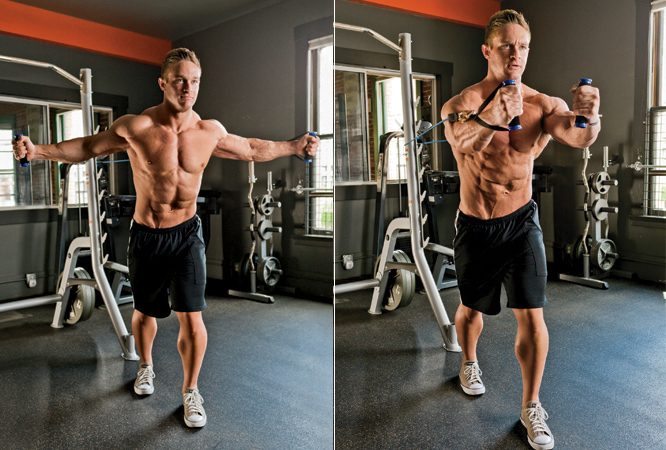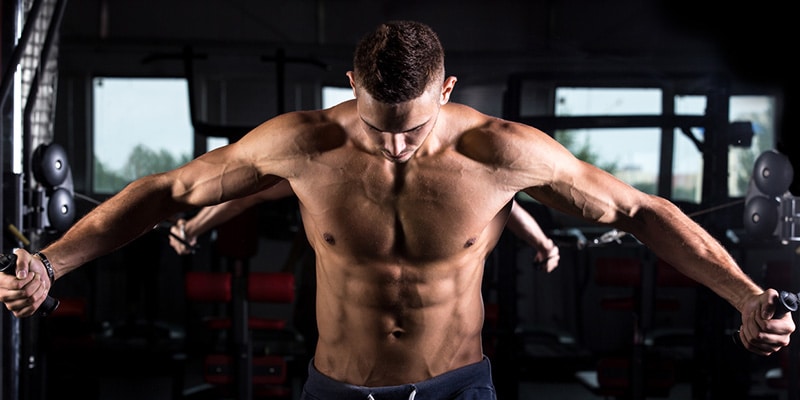We'll get started right away and show you in the next section how to properly do the chest press with the resistance band. Below you will find out which mistakes you should avoid and how to adapt the resistance to your progress. In the second part of the article we will look at chest variations and general information on chest training with resistance bands. Eventually you will learn how to incorporate chest exercises into your workout.
Are you looking for an effective way to strengthen your chest muscles without the need for heavy weights or expensive gym equipment? Look no further than the resistance band chest fly! This simple yet powerful exercise targets the pectoral muscles, helping you achieve a strong and well-defined chest. In this article, we will explore the benefits of the resistance band chest fly and guide you on how to perform this exercise correctly. Get ready to take your chest workout to the next level!
What is a Resistance Band Chest Fly?

Image Source: google.com
A resistance band chest fly is a variation of the classic dumbbell chest fly exercise. Instead of using weights, you utilize a resistance band to create tension and resistance as you move through the exercise. The resistance band is a flexible and portable tool that allows you to effectively target your chest muscles anywhere, be it at home, the gym, or even while traveling.
How to Perform a Banded Chest Fly?
Setup: Begin by anchoring the resistance band securely at chest height. You can loop it around a sturdy pole or use a door anchor specifically designed for resistance band exercises.
Stance: Stand with your back straight and feet shoulder-width apart. Hold one end of the resistance band in each hand, ensuring there is tension in the band.
Starting Position: Extend your arms forward with palms facing inwards, keeping a slight bend in your elbows. This is your starting position.
Execution: Engage your chest muscles and slowly open your arms out to the sides, maintaining a slight bend in your elbows throughout the movement. Imagine hugging a tree as you bring your arms back together, crossing them in front of your chest.
Breathing: Exhale as you open your arms and inhale as you bring them back together.
Repetitions: Aim for 10-15 repetitions per set, gradually increasing the number of sets as your strength improves.
Benefits of Resistance Band Chest Fly The

Image Source: google.com
Resistance band chest fly offers numerous benefits that make it a valuable addition to any chest workout routine:
Increased Chest Muscle Activation: The resistance band creates constant tension throughout the exercise, resulting in enhanced muscle activation in the chest muscles. This leads to optimal muscle growth and strength development.
Versatility: With a resistance band, you have the flexibility to perform chest fly variations at different angles, targetting different areas of the chest. This versatility allows you to customize your workout according to your specific goals.
Joint-Friendly: Unlike heavy weights, resistance bands provide a more joint-friendly workout. The controlled resistance minimizes the stress on your joints, reducing the risk of injury while still providing an effective chest workout.
Convenience: Resistance bands are lightweight and portable, making them a convenient fitness tool. You can easily pack them in your bag and perform resistance band chest flies anywhere, whether you're at home, in a hotel room, or at the park.
Cost-Effective: Resistance bands are an affordable alternative to bulky gym equipment. Investing in a high-quality resistance band allows you to achieve an effective chest workout without breaking the bank.
Tips for a Successful Resistance Band Chest Fly

Image Source: google.com
Choose an appropriate resistance band that challenges your chest muscles without compromising your form.
Focus on proper form and technique banded chest fly. Maintain a controlled and slow movement to target your chest muscles effectively.
Warm up your chest muscles with light stretching or a few sets of push-ups before starting the resistance band chest fly.
Gradually increase the resistance or tension of the band as your strength improves. This will continue to challenge your chest muscles and promote continuous progress.
Incorporate the resistance band chest fly into your regular chest workout routine at least twice a week for optimal results.
How to Do Chest Exercises With Resistance Bands?
Warming up is the first step of any exercise. Don't skip this one. Your muscles will be prepared for training and you will have less risk of injury. This leads to greater and faster progress in the long term.
For effective chest opening, an anchor is needed to hold the tape in place. We also strongly recommend the use of gloves to protect your hands from friction. If you don't already have this equipment, check out these: Door Anchors and Training Gloves.
Related Post: Maximizing Your Chest Workouts With Dumbbells Without Bench
The main purpose of the chest movement is to move the arm forward. in the center and also further out on the body, and you do this by attaching the resistance band to a door with an anchor, or to a pole, shelf, or something else. (Be sure to follow our guide on door anchors to keep them safe!)
In Conclusion
If you're craving a stronger and more defined chest, the resistance band chest fly is a fantastic exercise to incorporate into your fitness regimen. Not only does it target the chest muscles effectively, but it also provides a convenient and joint-friendly workout option. With a resistance band and a little determination, you can achieve impressive results in the comfort of your own home or wherever your fitness journey takes you. So grab a resistance band, take control of your workout, and get ready to unleash your chest muscles' full potential!
Frequently Asked Questions!
Are Resistance Band Chest Exercises Good?
Resistance band chest exercises are an isolation exercise for the chest and legs. Anterior delts. Compared to dumbbell pectoral flies, the resistance curve of banded pectoral flies is more evenly distributed, and the pectoral muscles are engaged more evenly throughout the range of motion.
What Muscles Does the Chest Lift Train?
The chest lift with dumbbells is a muscle isolation exercise. The upper body trains the pectoral and deltoid muscles, as well as the triceps and biceps. locked to stabilize the movement. In addition to developing muscles, this exercise can help open the chest and improve flexibility, master the retraction of the shoulder blades and improve coordination.
If You Do a Lot of Exercises for Your Chest?
When performing dumbbell chest exercises to open your chest muscles, you should use lighter weights or no weights at all. This can help you use your full range of motion without overextending yourself. Overstretching can lead to injuries.
Can You Build Muscle With Resistance Bands?
Practicing resistance do ligaments build muscles? Absolutely. In fact, a 2019 study shows that training with resistance bands leads to strength gains similar to those achieved with traditional fitness equipment. "Resistance bands may not seem like much, but they can strengthen muscles just as effectively as traditional weights.
Is a Fly to the Chest a Push or a Pull?
Is a fly to the chest a push or a pull? The chest opening uses adduction, a pressing motion as the handles are pushed toward the midline of the body.
Chest Openings Influence the Shoulders?
Dumbbells are ideal for training shoulders, chest and triceps. There are several exercises you can do to train your shoulder and chest muscles. However, the exercises have the unique advantage of training the ability of the pectoral muscles to move towards the center of the body, a movement called abduction.
It Is - What It Is the Bench? Better Than the Bench?
The bench beats the flies in terms of average muscle activation. All target muscle groups, including pectoral muscles – see data below. Flying stimulated the biceps more. Interestingly, biceps activity was probably high enough to stimulate muscle growth in the flies.
